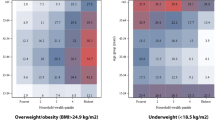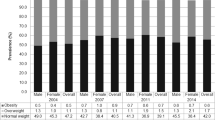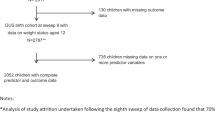Abstract
Background/Objectives:
State-specific obesity prevalence data are critical to public health efforts to address the childhood obesity epidemic. However, few states administer objectively measured body mass index (BMI) surveillance programs. This study reports state-specific childhood obesity prevalence by age and sex correcting for parent-reported child height and weight bias.
Subjects/Methods:
As part of the Childhood Obesity Intervention Cost Effectiveness Study (CHOICES), we developed childhood obesity prevalence estimates for states for the period 2005–2010 using data from the 2010 US Census and American Community Survey (ACS), 2003–2004 and 2007–2008 National Survey of Children’s Health (NSCH) (n=133 213), and 2005–2010 National Health and Nutrition Examination Surveys (NHANES) (n=9377; ages 2–17). Measured height and weight data from NHANES were used to correct parent-report bias in NSCH using a non-parametric statistical matching algorithm. Model estimates were validated against surveillance data from five states (AR, FL, MA, PA and TN) that conduct censuses of children across a range of grades.
Results:
Parent-reported height and weight resulted in the largest overestimation of childhood obesity in males ages 2–5 years (NSCH: 42.36% vs NHANES: 11.44%). The CHOICES model estimates for this group (12.81%) and for all age and sex categories were not statistically different from NHANES. Our modeled obesity prevalence aligned closely with measured data from five validation states, with a 0.64 percentage point mean difference (range: 0.23–1.39) and a high correlation coefficient (r=0.96, P=0.009). Estimated state-specific childhood obesity prevalence ranged from 11.0 to 20.4%.
Conclusion:
Uncorrected estimates of childhood obesity prevalence from NSCH vary widely from measured national data, from a 278% overestimate among males aged 2–5 years to a 44% underestimate among females aged 14–17 years. This study demonstrates the validity of the CHOICES matching methods to correct the bias of parent-reported BMI data and highlights the need for public release of more recent data from the 2011 to 2012 NSCH.
This is a preview of subscription content, access via your institution
Access options
Subscribe to this journal
Receive 12 print issues and online access
$259.00 per year
only $21.58 per issue
Buy this article
- Purchase on Springer Link
- Instant access to full article PDF
Prices may be subject to local taxes which are calculated during checkout

Similar content being viewed by others
References
Blondin K, Giles CM, Gortmaker SL, Cradock AL, Resch SC, Wang YC et al Improving state childhood obesity surveillance: a review of current practice and recommendations for change. Prev Chronic Dis 2016; 13: 160060.
Dietz WH . Letter re PedNSS and PNSS: U.S. Centers for Disease Control and Prevention; 2011. Available at: http://www.nj.gov/health/fhs/shapingnj/news/newsletter/documents/Letter%20re%20PedNSS%20and%20PNSS.pdf last accessed 16 June 2016.
Youth Risk Behavior Surveillance System (YRBSS): U.S. Centers for Disease Control and Prevention; 2015. Available at: http://www.cdc.gov/healthyyouth/data/yrbs/index.htm. (last accessed 15 July 2015).
Gosse MA . How accurate is self-reported BMI? Nutr Bull 2014; 39: 105–114.
Brener ND, McManus T, Galuska DA, Lowry R, Wechsler H . Reliability and validity of self-reported height and weight among high school students. J Adolesc Health 2003; 32: 281–287.
Singh GK, Kogan MD, van Dyck PC . Changes in state-specific childhood obesity and overweight prevalence in the United States from 2003 to 2007. Arch Pediatr Adolesc Med 2010; 164: 598–607.
Connor Gorber S, Tremblay M, Moher D, Gorber B . A comparison of direct vs. self-report measures for assessing height, weight and body mass index: a systematic review. Obes Rev 2007; 8: 307–326.
Akinbami LJ, Ogden CL . Childhood overweight prevalence in the United States: the impact of parent-reported height and weight. Obesity 2009; 17: 1574–1580.
Weden MM, Brownell PB, Rendall MS, Lau C, Fernandes M, Nazarov Z . Parent-reported height and weight as sources of bias in survey estimates of childhood obesity. Am J Epidemiol 2013; 178: 461–473.
Cawley J, Burkhauser R Beyond BMI: the Value of More Accurate Measures of Fatness and Obesity in Social Science Research. NBER Working Paper Series 2006;Working Paper 12291.
Gortmaker SL, Wang YC, Long MW, Giles CM, Ward ZJ, Barrett JL et al. Three interventions that reduce childhood obesity are projected to save more than they cost to implement. Health Aff (Millwood) 2015; 34: 1932–1939.
Blumberg SJ, Foster EB, Frasier AM, Satorius J, Skalland BJ, Nysse-Carris KL et al. Design and operation of the National Survey of Children's Health, 2007. Vital Health Stat 1 2012; 55: 1–149.
Blumberg SJ, Olson L, Frankel MR, Srinath LO, Giambo KP . Design and operation of the National Survey of Children's Health, 2003. Vital Health Stat 2005; 1: 1–124.
Arkansas Center for Health Improvement. Assessment of Childhood and Adolescent Obesity in Arkansas: Year Eleven (Fall 2013-Spring 2014). Little Rock, AR, USA, 2014. Available at http://achi.net/Docs/274/ last accessed 16 June 2016.
School Health Services Program, Florida Department of Health. State of Florida 2013–2014 Summary of School Health Services. Tallahassee, FL, USA, 2015. Available at http://www.floridahealth.gov/programs-and-services/childrens-health/school-health/_documents/13_14_county_data_summary.pdf (last accessed 16 June 2016).
School Health Unit, Bureau of Community Health and Prevention, Massachusetts Department of Health. Results from the Body Mass Index Screening in Massachusetts Public School Districts, 2014. Boston, MA, USA, 2015. Available at http://www.mass.gov/eohhs/docs/dph/com-health/school/status-childhood-obesity-2014.pdf last accessed 16 June 2016.
Division of School Health, Bureau of Community Health Services, Pennsylvania Department of Health. Growth Screens/BMI-For-Age Percentiles by Health District and County, 2012–2013 School Year. Harrisburg, PA, USA, 2015. Available at http://www.health.pa.gov/My%20Health/School%20Health/Documents/Mandated%20School%20Health%20Program/Growth%20Screen/2012-13BMIByCounty.pdf (last accessed 16 June 2016).
Division of Policy Planning, and Assessment, Tennessee Department of Health. A summary of Weight Status Data: Tennessee Public Schools, 2012–2013 School Year. Nashville, TN, USA, 2013. Available at https://www.tn.gov/assets/entities/education/attachments/csh_bmi_school_summary_2012-13.pdflast accessed 16 June 2016.
D'Orazio M Statistical Matching and Imputation of Survey Data with StatMatch. StatMatch R package vignette. 2014. Available at: http://cran.r-project.org/web/packages/StatMatch/vignettes/Statistical_Matching_with_StatMatch.pdf.
D'Orazio M, Di Zio M, Scanu M . Statistical Matching: Theory and Practice. Wiley: Chichester, England; Hoboken, NJ, 2006. x, 256 p.
Vantaggi B . Statistical matching of multiple sources: a look through coherence. Int J Approx Reason 2008; 49: 701–711.
Ward ZJ, Long MW, Resch SC, Gortmaker SL, Cradock AL, Giles CM et al. Redrawing the US obesity landscape: bias-corrected estimates of state-specific adult obesity prevalence. PLoS One 2016; 11: e0150735.
Ogden CL, Carroll MD, Kit BK, Flegal KM . Prevalence of childhood and adult obesity in the United States, 2011–2012. JAMA 2014; 311: 806–814.
Kelly AS, Barlow SE, Rao G, Inge TH, Hayman LL, Steinberger J et al. Severe obesity in children and adolescents: identification, associated health risks, and treatment approaches: a scientific statement from the American Heart Association. Circulation 2013; 128: 1689–1712.
Acknowledgements
This work was supported in part by grants from The JPB Foundation, the Robert Wood Johnson Foundation (Grant No. 66284), the Donald and Sue Pritzker Nutrition and Fitness Initiative, and the Centers for Disease Control and Prevention (Grant No. U48DP001946), including the Nutrition and Obesity Policy Research and Evaluation Network. YC Wang is partly supported by a grant from the National Cancer Institute (1R01CA172814-01A1).
Author information
Authors and Affiliations
Corresponding author
Ethics declarations
Competing interests
The authors declare no conflict of interest.
Disclaimer
This work is solely the responsibility of the authors and does not represent the official views of the Centers for Disease Control and Prevention or any of the other funders.
Additional information
Supplementary Information accompanies this paper on International Journal of Obesity website
Supplementary information
Rights and permissions
About this article
Cite this article
Long, M., Ward, Z., Resch, S. et al. State-level estimates of childhood obesity prevalence in the United States corrected for report bias. Int J Obes 40, 1523–1528 (2016). https://doi.org/10.1038/ijo.2016.130
Received:
Revised:
Accepted:
Published:
Issue Date:
DOI: https://doi.org/10.1038/ijo.2016.130
This article is cited by
-
How is weight stigma related to children’s health-related quality of life? A model comparison approach
Quality of Life Research (2018)



